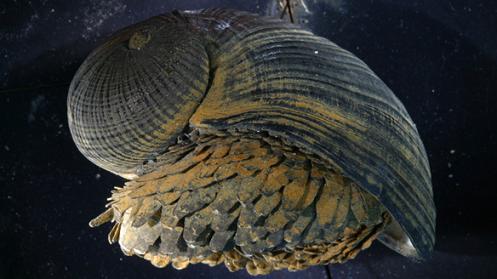
« PREVIOUS ENTRY
Garry Kasparov, cyborg

Life isn’t easy for the “scaly-foot gastropod”. This humble snail lives in hydrothermal vent fields two miles deep in the Indian ocean, and is surrounded by vicious predators. For example, there’s the “cone snail”, which stabs at its victims with a harpoon-style tooth as a precursor to injecting them with paralyzing venom. Then there’s the Brachyuran crab, which has been known to squeeze its prey for three days in an attempt to kill it. Yowsa.
Ah, but the scaly-foot gastropod has its own tricks. To fight back, it long ago evolved a particularly cool defense structure: It takes the grains of iron sulfide floating in the water around it and incorporates it into the outer layer of its shell. It it thus an “iron-plated snail”.
Oh yes way. Scientists discovered Crysomallon squamiferum in 1999, but they didn’t know a whole lot about the properties of its shell until this month, when a team led by MIT scientists decided to study it carefully. The team did a pile of spectroscopic and microscopic measurements of the shell, poked at it with a nanoindentor, and built a computer model of its properties to simulate how well it would hold up under various predator attacks.
The upshot, as they write in their paper (PDF here), is that the shell is “unlike any other known natural or synthetic engineered armor.” Part of its ability to resist damage seems to be the way the shell deforms when it’s struck: It produces cracks that dissipate the force of the blow, and nanoparticles that injure whatever is attacking it:
Within the indent region, consolidation of the granular structure is observed within and around the indent. Localized microfractures exhibit tortuous, branched, and noncontinuous pathways, as well as jagged crack fronts resulting from separation of granules, all of which are beneficial for energy dissipation and preventing catastrophic brittle fracture. Such microfracture modes may serve as a sacrificial mechanism. Upon indentation, inelastic deformation will be localized in the softer organic material between the granule interfaces, which allows for intergranular displacement and friction while simultaneously being compressed down into the softer ML. Shear of iron sulfide nanoparticles against the indenter surface is expected, in particular since penetrating attacks take place off-angle rather than directly on top of the shell apex, and can be facilitated by intergranular displacements during yielding of the OL. This provides a potential grinding abrasion and wear mechanism to deform and blunt the indenter (since biological penetrating threats are in reality deformable as well) that will continue throughout the entire indentation process.
Beyond awesome. This is Darwinian evolution mixed with, like, Burning Man.
Being scientists of biomimicry, the authors surmise that if it were possible to reverse-engineer the entire shell — it’s not just the outer iron layer that’s cool; there are also two inner layers with gooey nougat that are equally important in defending the snail — they could produce superstrong materials for military defense and “load-bearing”.
Fair enough. But personally I’m satisfied just to have more pure science that proves, yet again, the inexhaustible Weirdness Of The Briny Deep.
Iron snails, people! Iron snails.
(Thanks to the Eco Tone blog for alerting me to this one!)
I'm Clive Thompson, the author of Smarter Than You Think: How Technology is Changing Our Minds for the Better (Penguin Press). You can order the book now at Amazon, Barnes and Noble, Powells, Indiebound, or through your local bookstore! I'm also a contributing writer for the New York Times Magazine and a columnist for Wired magazine. Email is here or ping me via the antiquated form of AOL IM (pomeranian99).

ECHO
Erik Weissengruber
Vespaboy
Terri Senft
Tom Igoe
El Rey Del Art
Morgan Noel
Maura Johnston
Cori Eckert
Heather Gold
Andrew Hearst
Chris Allbritton
Bret Dawson
Michele Tepper
Sharyn November
Gail Jaitin
Barnaby Marshall
Frankly, I'd Rather Not
The Shifted Librarian
Ryan Bigge
Nick Denton
Howard Sherman's Nuggets
Serial Deviant
Ellen McDermott
Jeff Liu
Marc Kelsey
Chris Shieh
Iron Monkey
Diversions
Rob Toole
Donut Rock City
Ross Judson
Idle Words
J-Walk Blog
The Antic Muse
Tribblescape
Little Things
Jeff Heer
Abstract Dynamics
Snark Market
Plastic Bag
Sensory Impact
Incoming Signals
MemeFirst
MemoryCard
Majikthise
Ludonauts
Boing Boing
Slashdot
Atrios
Smart Mobs
Plastic
Ludology.org
The Feature
Gizmodo
game girl
Mindjack
Techdirt Wireless News
Corante Gaming blog
Corante Social Software blog
ECHO
SciTech Daily
Arts and Letters Daily
Textually.org
BlogPulse
Robots.net
Alan Reiter's Wireless Data Weblog
Brad DeLong
Viral Marketing Blog
Gameblogs
Slashdot Games